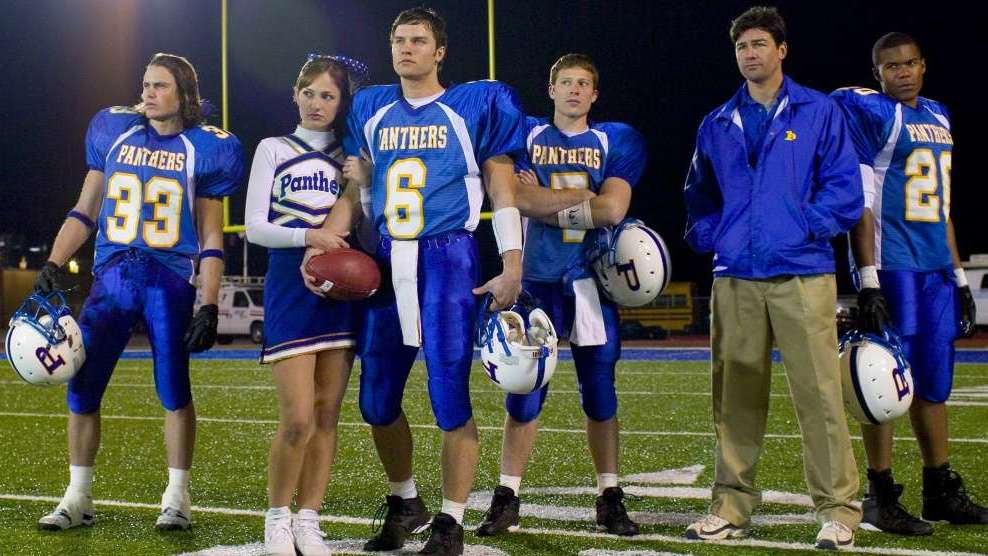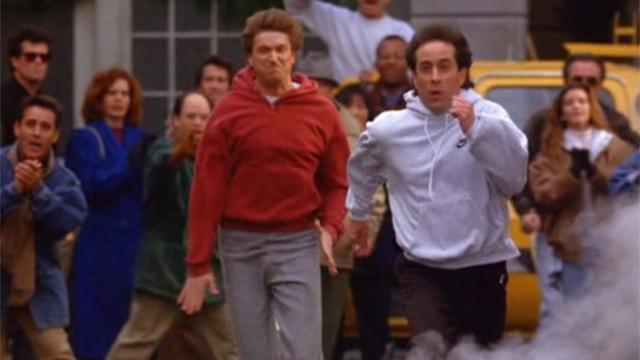Seinfeld/NBC
I love bodyweight workouts. They’re efficient, effective, and cheap — no gym membership required. All I need is a few feet of floor space, and I’m ready to alternate sets of squats and lunges.
But bodyweight exercises are also — let’s be honest — a little boring. They require just enough mental attention that you can’t fully concentrate on anything else, but are repetitive enough that you could spend the entire time thinking about how tedious planks are, and how tired your arms and abs are getting.
I know from experience that once you start thinking about how tired you are, you’re probably going to start coming up with excuses to quit your workout early. So I look for ways to distract myself from the pains and gains of pushups and burpees — and the best distraction I’ve found is ’90s television.
This Was Before DVR
I’m not sure all of us remember what ’90s television was like. It’s engaging — these were the years of Seinfeld, Friends, and “Must-See TV” — but it’s also really slow. It was designed for audiences who couldn’t pause the television when the phone rang, or rewind ten seconds to catch a line of dialogue they missed. It was also designed to allow you to start watching at any time — because people could turn on the TV at any time — and still understand the entire story.
Networks knew their shows were being watched by people who were also eating dinner, doing homework, folding clothes — maybe even doing squat thrusts or running in place during the commercial breaks. (Remember when all the magazines advised us to run in place during the commercial breaks?) So they made sure the shows could be entertaining even if people weren’t able to give them their full attention.
Everything Else Is Just Too Fast
Which makes ’90s TV the perfect companion to a bodyweight workout. I’ve tried other methods of distraction, like podcasts, and the words go by too quickly; if I miss a sentence as I’m counting crunches in my head, I lose the entire thread of the conversation.
But if I have Dr. Quinn, Medicine Woman going in the background, I can stop paying attention for a full 30 seconds and not miss a thing.
The Nostalgia Factor
For those of us old enough to have grown up asking ourselves whether we were a Rachel, a Monica, or a Phoebe (I was obviously a Monica — and, when I got a little older, a Miranda), there’s a heavy dose of nostalgia with ’90s shows. Building muscle is uncomfortable, and nostalgia is comforting.
If your nostalgia era hits a little later than mine does, early ’00s television works nearly as well. I squatted my way through all five seasons of Friday Night Lights, which ran from 2006 — 2011, mostly because I didn’t pay attention to the football parts.

Friday Night Lights/NBC
The original run of Gilmore Girls (2000-2007) was a little harder — it started out as a good workout show, especially because most of the plot and emotion was conveyed through the dialogue rather than the images, but by the end of the series the episodes required the kind of mental and visual energy I couldn’t give while doing pushups.
You’ll probably notice a similar shift as you watch TV shows that end in the late ‘oos or early ’10s, because that’s when television started to transform into the type of high-density, high-focus content that prompts us to binge entire seasons in a night. By 2007, we had gone from TiVos to TV Tropes, and YouTube and Netflix were introducing people to the idea of streaming television online, at their own pace. People were watching — and discussing — television much more closely, and the shows got more complex as a result.
Let’s Analyse a Scene from Classic ’90s Television
Just how slow is ’90s TV? Here’s the climactic scene from Dr. Quinn, Medicine Woman’s second-season episode “Where The Heart Is: Part 2,” which has the honour of being the highest-rated episode of the six-season-and-two-movies series:
The first minute of this scene can be best described as “filler.” We watch Dr. Quinn walk down a train corridor three times; twice in medium shot and once in closeup. (She’s looking for Sully.) We get two different background actors reacting confusedly, just so everyone remembers that this show is about an unconventional woman. We see Sully enter a train compartment — during which the camera lingers on his crotch for a full five seconds — and slowly remove every bag, bedroll, and water pouch he’s carrying.
Then Dr. Quinn finally finds Sully, and we finally get dialogue:
DR. QUINN: What are you doing?
SULLY: That’s pretty clear.
DR. QUINN: You’re just leaving?
SULLY: There’s nothin’ to stay for.
DR. QUINN: Without even saying goodbye?
[Pause.]
SULLY: Goodbye.
DR. QUINN: Why did you even come here?
SULLY: I told you.
DR. QUINN: Well, what’s the real reason?
SULLY: What do you care?
DR. QUINN: I care!
SULLY: Well, you sure didn’t look like it back there at that meetin’!
DR. QUINN: I’m asking you a question.
SULLY: Why did I come?
DR. QUINN: Yes. Why.
SULLY: Because.
DR. QUINN: Because?
SULLY: Because I love you.
You can do a lot of pushups during that scene and still get the gist of it. If you’re doing something like squat thrusts, you’ll see the screen during one out of every four motions — which is often enough to catch everything important that happens. If you’re at the end of a plank pose and you miss a few lines of dialogue because you’re focusing on your core, it won’t matter because ’90s TV repeats itself. Constantly. Just like all those reps you’re doing.

Comments